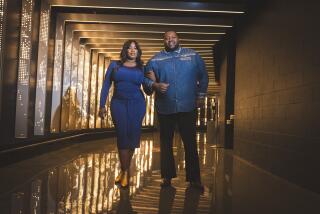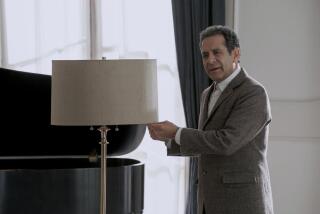The Monkees are just trying to be friendly, 40 years on
The Monkees haven’t toured together in more than four decades, so it seemed only logical that at a rehearsal this week in North Hollywood, the band’s three surviving members might not be in sync.
But two days ahead of a short reunion tour that began Thursday in Escondido, Micky Dolenz, Michael Nesmith and Peter Tork communicated in a secret language as if it were still 1969.
In the middle of a long jam, Nesmith, 69, took his hands off his vintage-style Gretsch guitar and began addressing Dolenz in an elaborate sequence of arm and hand signals (think of ground crew guiding a plane in at LAX). Dolenz, 67, quickly answered in similar body language from behind his gold metal-flake drum kit. Tork smiled.
PHOTOS: The Monkees reunion tour
Nesmith, who hasn’t taken part in a full-fledged U.S. tour with the other Monkees since 1969, then translated. “This means,” he said haltingly as he continued gesturing, “chili … dog … with … cheese.”
You can take the man out of the Monkees, but … well, you know where this is going.
Humor is a key element in the camaraderie among these men, who along with the late singer Davy Jones vaulted to fame in 1966 with their hit TV show “The Monkees” and the string of recordings they made for each week’s episode. Even though they were originally hired to portray a zany famous rock band on TV, the songs made bona-fide pop stars out of the four amateur actors-musicians.
Following their first run-through of the whole set at a dress rehearsal Wednesday in Escondido, Nesmith exhibited genuine curiosity, and a little nervousness, when he asked a visitor how the show would come across: “Do you think Monkees’ fans will like it?”
Nesmith has reason to question how they’ll be received since the band will be touring without one of its lead singers, who was the British heartthrob of the band in the TV series. The reunion tour, which plays the Greek Theatre on Saturday, follows Jones’ death this year of a heart attack. He’d toured periodically with Dolenz and Tork since the Monkees released their final album in 1970 and is being saluted in this round of shows through photos, film footage and recordings of some of his songs.
“Of course we miss Davy,” Tork, 68, said, “and it’s sad to be playing without him. But when Davy, Micky and I were touring, it was sad to play without Mike.”
Over the years Nesmith skipped most of the Monkees reunions, citing commitments related to his solo career — including running the Pacific Arts music and video label he launched in the ‘70s, producing films (including “Repo Man”) and writing two novels. (Nesmith trivia: He produced music videos for Lionel Richie’s 1983 single “All Night Long (All Night)” and Michael Jackson’s 1987 hit “The Way You Make Me Feel.”)
Hollywood Star Walk: The Monkees
But behind the scenes, Jones made remarks during the ’97 British tour that hinted at tension with Nesmith, and the 2011 Monkees tour ended prematurely because of reported disagreements Dolenz and Tork had with Jones regarding business facets of the tour.
That’s all water under the bridge. “This show, it’s not about a loss, it’s not a memorial,” Nesmith said. “It’s acknowledging the gain and the contribution that David made. At this time of our lives, we don’t have illusions about what this is: It’s about the good work we did.”
The Monkees’ career lasted barely four years but yielded four No. 1 albums, half a dozen Top 10 singles, three of which reached No. 1, a TV series that’s become a comedy classic that still airs around the world and the avant-garde 1968 film, “Head,” which reflected the anarchic zeitgeist of the late-’60s while satirically relating the story of the Monkees’ rise from creative puppets to masters of their own fate.
“There’s no other story like it in entertainment,” said music historian Andrew Sandoval, author of the 2005 career diary “The Monkees.” “They released their first single in August 1966, the show premiered in September, and by January they’d won their fight for artistic control. It’s as if the contestants on ‘American Idol’ came in one day and said, ‘Fire the judges and the producers, we’re taking over.’ ”
That refers to the famous showdown between the Monkees — with Nesmith leading the charge — and music world impresario Don Kirshner, who controlled the music the group recorded, largely from his bevy of esteemed Brill Building songwriters including Carole King and Gerry Goffin, Tommy Boyce and Bobby Hart, and Neil Diamond.
Kirshner also had an authoritarian hand over how the band’s records were made and packaged. The contributions of ace Hollywood studio musicians who played most of the music on the group’s first two albums, “The Monkees” and “More of the Monkees,” went largely uncredited, creating the impression that all the music was played by Dolenz, Jones, Nesmith and Tork.
“When they handed me the second album and there were no musician credits on it, I started to smell a rat,” Nesmith said. “My position was, ‘If you don’t need me for this. Replace me. Tell people, “Michael died. Here’s the new guy, his name isn’t Michael, it’s Bubba.” ’ But the reaction was, ‘No, you’re right, there is something good here.’ That’s where the [1968 film] ‘Head’ came from.
“We thought it was a huge victory,” he said. “It was hard fought and it was brutal but it was worth it.... We came up against a corporate monster and just said no — and not in the Reagan-era sense of the word. In that sense, people recognized we don’t need to be making stuff up. If you look at what we’re actually doing, it takes your breath away.”
That bit of pop history will underscore this tour, a portion of which will be devoted to their third album, 1967’s “Headquarters,” the first after the battle the led to Kirshner’s ousting.
“It’s the first album we were the musicians on, the first which we had creative control over,” said Tork, who performs and records with his own band, Shoe Suede Blues, when he’s not occupied with Monkees business, while Dolenz has kept active in musical theater and recently released a new solo album, “Remember.” “We were very pleased with ourselves — rightly or wrongly — with that album.”
The reunion show also will include all the songs from “Head,” the experimental film written by Jack Nicholson and Bob Rafelson.
Today the Monkees have no shortage of fans, and not all of them are boomers. The TV show went into syndication in the 1970s, then became a major hit with a new generation at the dawn of MTV, which ran episodes three times a day in the 1980s, leading to a major Monkees revival. Their original studio albums were reissued and returned the group to the Billboard charts two decades after it formed.
Nesmith, a pioneer of video music who received the first music video Grammy Award 20 years ago, recently set Monkees fans abuzz when he wrote on his Facebook page that Jimmy Fallon was begging to sing “Daydream Believer” in Jones’ place on the upcoming tour, then subsequently teased that Kevin Spacey was lobbying for the job.
“I think I was just channeling Mike of the Monkees, reconnecting with his impish self,” he said. “I started to see from the feedback of [fans] responding to the notion about who should sing ‘Daydream Believer’ where it fit into so many people’s lives.”
But of the fans who bemoan that the Rock and Roll Hall of Fame has never inducted the Monkees, group members aren’t among them. “It’s their museum [and] I don’t feel the least bit slighted, or snubbed in any way,” said Nesmith, the Texas-born musician famous for his green knit beanie and who was originally pigeonholed as “the smart Monkee.”
“The Monkees will be wherever they belong — I have a lot of confidence in that because of where we have popped up, in the right places, over time,” Nesmith said. “Put the Monkees in the Smithsonian if you want to do something worthwhile in terms of memorializing the band’s place in the culture.”
Back in the day the Monkees’ legitimacy was often questioned by those out of grade school, but it was never an issue for the band they were partly modeled after, the Beatles.
“The Beatles always got the whole Monkee thing,” Dolenz said, adopting a Liverpudlian accent to quote John Lennon: “It was John who was the first one to say, ‘It’s like the Marx Brothers.’”
“The Monkees were in the mix with most of the lions of rock ‘n’ roll,” Nesmith said, “but we got there by special permission because of the TV show. None of us are fooling ourselves into thinking we are one of the great classic-rock bands. We are kind of an iconic garage band, sort of the inmates taking over the asylum, and we have a lot of fun.”
[For the record, 5:01 p.m. Nov. 9: Peter Tork’s age is misstated in this post. He is 70, not 68.]
PHOTOS AND MORE:
PHOTOS: Iconic rock guitars and their owners
The Envelope: Awards Insider
PHOTOS: Unfortunately timed pop meltdowns
More to Read
The biggest entertainment stories
Get our big stories about Hollywood, film, television, music, arts, culture and more right in your inbox as soon as they publish.
You may occasionally receive promotional content from the Los Angeles Times.










